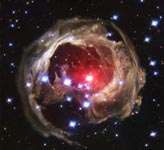Seeds of life may have formed in the winds of black holes

Washington, Oct 10 : Space dust – the same stuff that makes up living creatures and planets – was manufactured in large quantities in the winds of black holes that populated our early universe, new findings by the NASA’s Spitzer Space Telescope has revealed.
“We were surprised to find what appears to be freshly made dust entrained in the winds that blow away from supermassive black holes,” said Ciska Markwick-Kemper of the University of Manchester, UK.
“This could explain where the dust came from that was needed to make the first generations of stars in the early universe,” she said.
Space dust is essential to the formation of planets, stars, galaxies and even life. The dust in our corner of the universe was piped out by dying stars that were once a lot like our Sun.
But, when the universe was less than a tenth of its present age of 13.7 billion years, Sun-like stars hadn't been around long enough to die and make dust.
Scientists have postulated several theories, including ones that say that short-lived, massive exploding stars, or supernovae, was the probable source of this mysterious dust, and others that propose that a type of energetic, growing supermassive black hole, called a quasar, could be a contributing factor.
A quasar consists of a supermassive black hole surrounded by a dusty doughnut-shaped cloud that feeds it. Theoretically, dust could form in the outer portion of the winds that slowly blow away from this doughnut cloud.
“Quasars are like the Cookie Monster. They are messy eaters, and they can consume less matter than they spit out in the form of winds,” said co-author Sarah Gallagher of the University of California at Los Angeles.
As nobody has found conclusive proof that either quasar winds or supernovae can create enough dust to explain what is observed in the early universe, Markwick-Kemper and her team decided to test the former theory and investigate a quasar, called PG2112+059, located in the centre of a galaxy about eight billion light-years way.
The team used Spitzer's infrared spectrograph instrument to split apart infrared light from the quasar and look for signs of various minerals, and found a mix of the ingredients that makes up glass, sand, marble and even rubies and sapphires.
While the mineral constituting glass was expected, the minerals for sand, marble and rubies were a surprise, as these minerals are not typically detected floating around galaxies.
As such, the researchers opine, they could have been freshly formed in the winds rushing away from the quasar.
Markwick-Kemper said as the ingredient that makes up sand, crystalline silicate, “doesn't survive for long free-floating in space, (radiation from stars zaps the minerals back to an amorphous, glass-like state), the presence of crystalline silicate suggests that possibly the quasar winds is churning out the newly made substance”.
Markwick-Kemper and her team plan to study more quasars for further evidence of their dust-making abilities.
The study appears in an upcoming issue of the Astrophysical Journal Letters. (ANI)